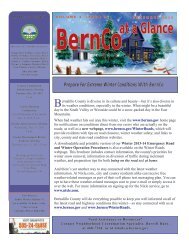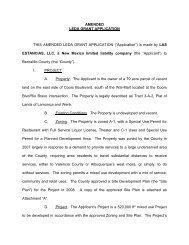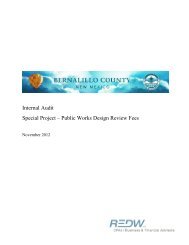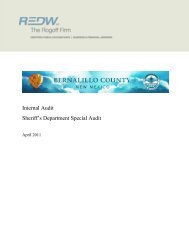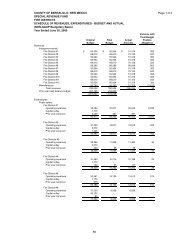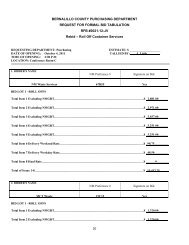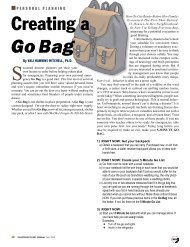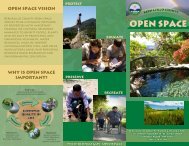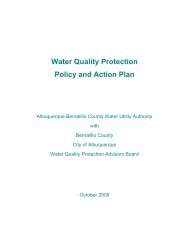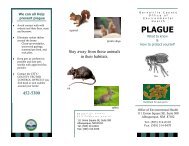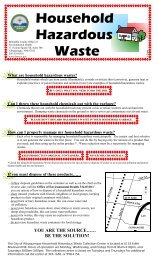East Mountain Trails & Bikeways Master Plan - Bernalillo County
East Mountain Trails & Bikeways Master Plan - Bernalillo County
East Mountain Trails & Bikeways Master Plan - Bernalillo County
Create successful ePaper yourself
Turn your PDF publications into a flip-book with our unique Google optimized e-Paper software.
Chapter I. Introduction<br />
<strong>Bernalillo</strong> <strong>County</strong> Parks & Recreation<br />
Department and Public Works Division initiated<br />
the preparation of the <strong>East</strong> <strong>Mountain</strong> <strong>Trails</strong> and<br />
<strong>Bikeways</strong> <strong>Master</strong> <strong>Plan</strong> in 2003. The plan is in<br />
response to residential growth in the area, a<br />
recommendation in the <strong>East</strong> <strong>Mountain</strong> Area <strong>Plan</strong>,<br />
and a request by the Greater Albuquerque<br />
Recreational <strong>Trails</strong> Committee (GARTC), which<br />
has representatives from unincorporated<br />
<strong>Bernalillo</strong> <strong>County</strong>.<br />
The intent of the <strong>Master</strong> <strong>Plan</strong> is to identify major<br />
trail and bikeway corridors and pivotal links<br />
between those corridors and major public Open<br />
Space areas and civic destinations for walking,<br />
hiking, bicycling, and riding horses. Over the long<br />
term, implementation of the plan will result in a<br />
network of connections between residential<br />
areas, commercial nodes, and public lands<br />
managed by the United States Forest Service,<br />
City of Albuquerque and <strong>Bernalillo</strong> <strong>County</strong>. The<br />
plan attempts to accommodate all user groups<br />
within the proposed system, although not on<br />
every trail.<br />
Rights-of-way for <strong>County</strong>-maintained roads,<br />
state-maintained routes, or utility easements are<br />
expected to be locations for some trail corridors.<br />
Drainage easements and some private roads<br />
may offer other possibilities. Finally, in some<br />
instances, private lands may be the only route for<br />
key links. Potential links were analyzed to<br />
determine the viability of securing public access<br />
through land purchase, easement acquisition, or<br />
other creative means.<br />
Adoption of the <strong>East</strong> <strong>Mountain</strong> <strong>Trails</strong> and<br />
<strong>Bikeways</strong> <strong>Master</strong> <strong>Plan</strong> will assist <strong>Bernalillo</strong><br />
<strong>County</strong> staff, developers, and neighborhoods in<br />
the subdivision design, review, and approval<br />
processes. The <strong>Master</strong> <strong>Plan</strong> will also be helpful in<br />
securing future state and federal funds for trail<br />
development and construction, and in prioritizing<br />
“Five Percent Set-Aside” funds dedicated to<br />
<strong>County</strong> trail and bikeway development per<br />
<strong>Bernalillo</strong> <strong>County</strong> Code 2-241.<br />
Section A. Background and Context<br />
The <strong>East</strong> <strong>Mountain</strong> Area is a predominantly rural<br />
collection of communities on the eastern side of<br />
the Sandia and Manzanita <strong>Mountain</strong>s in eastern<br />
<strong>Bernalillo</strong> <strong>County</strong>. The mountains form the<br />
western boundary of the area’s 316 square miles<br />
of piñon-juniper foothills and grasslands, except<br />
for a wide swath that cuts through Tijeras<br />
Canyon along I-40 until it reaches the<br />
Albuquerque City limits on the west. The area is<br />
also bounded on the west by Kirtland Air Force<br />
Base. To the east, the area extends to the Santa<br />
Fe <strong>County</strong> and Torrance <strong>County</strong> lines just east of<br />
NM 217 (<strong>Mountain</strong> Valley Road). Its border to the<br />
north is Sandoval <strong>County</strong> and to the south is the<br />
Chilili Land Grant and Isleta Pueblo.<br />
Historically, Native Americans and Spanish<br />
settlers traveled through Tijeras Canyon to reach<br />
timber forests and hunting and trading areas.<br />
Their historic villages were San Antonio, the early<br />
population and religious center of the Cañon de<br />
Carnuel Land Grant, Carnuel, Tijeras, Cañoncito,<br />
San Antonito, Sedillo, Chilili, Escabosa, and Juan<br />
Tomas. Water for some of the communities was<br />
developed from the springs at San Antonio (now<br />
the site of Ojito Open Space), Cole Springs (near<br />
Cañoncito), and La Cienega (near San Antonito).<br />
Other communities engaged in dryland farming.<br />
(EMAP 1992.)<br />
The area later developed with seasonal homes<br />
and cabins for city residents seeking relief from<br />
the seasonal heat and for tuberculosis patients<br />
seeking cures in the cold, dry climate. Over time,<br />
the <strong>East</strong> <strong>Mountain</strong> Area has primarily grown into<br />
an expanding bedroom community for people<br />
who work in Albuquerque and even Santa Fe,<br />
with average lot sizes of two acres or more.<br />
EAST MOUNTAIN TRAILS AND BIKEWAYS MASTER PLAN Page 1



